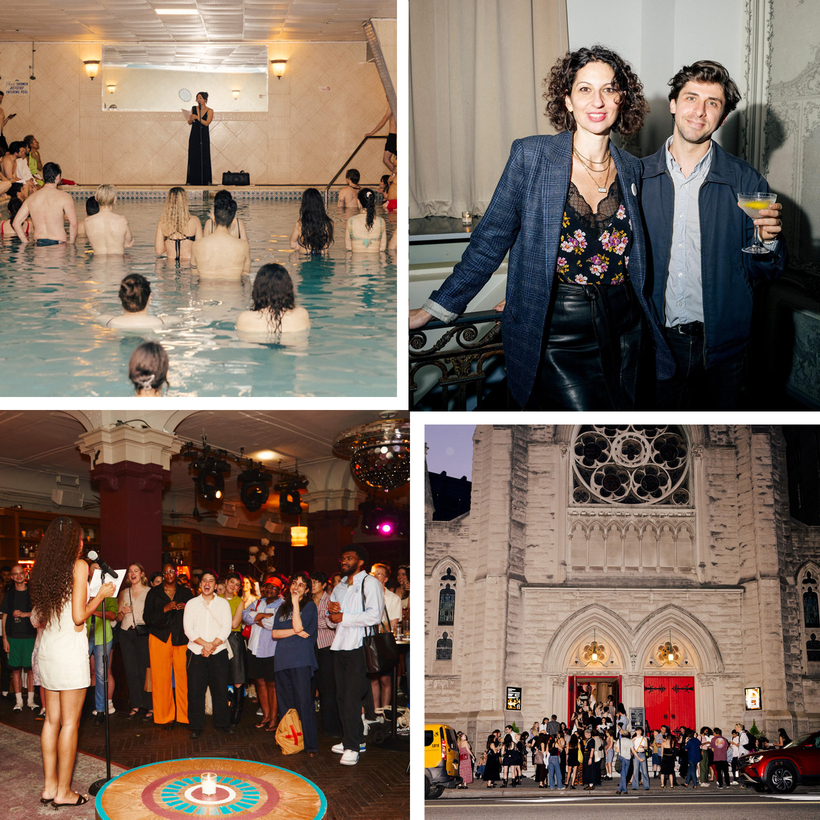Substack’s Manhattan office, located on the ninth floor of a nondescript Midtown building in the shadow of the Empire State Building, is small and spartan compared to many other media companies.
“Not what you thought our office would look like, is it?” asked Sophia Efthimiatou, the company’s head of writer relations, on a recent day. I was there to meet Efthimiatou and Matt Starr, Substack’s writer-relations producer, hoping they would shed light on how a venture-backed company founded by tech bros, whose most popular newsletters have millions-strong followings, has developed an events strategy that is incredibly niche and led by a former downtown darling.
I first met Starr a few years ago, when he was making indie movies—including an Annie Hall remake exclusively starring elderly people from the Lenox Hill Neighborhood House nursing home—and hosting poetry readings on the Lower East Side. At the time, he stuck out for how adept he was at getting talented and good-looking New Yorkers into hot, crowded rooms not long after the first coronavirus vaccines dropped.
The little scene, as well as Dream Baby, the literary press and events company he co-founded with his friend Zack Roif in 2022, served as an antidote to the mostly media-driven idea that a few blocks away there was something important happening in the section of Canal Street nicknamed after Dimes, the small, tight, celebrity-magnet restaurant that has always felt like it was meant for Los Angeles and not Manhattan’s Chinatown. Starr’s parties were filled with poets, octogenarian cabaret singers, Drake impersonators, and Jemima Kirke. Sometimes they were held in bars, but, more often, he hosted them in offbeat spots such as boxing gyms and Burger Kings.
Efthimiatou, Starr, and I sat in Substack’s small conference room, a screen saver flashing an image of the company’s homeland of San Francisco on the flat-screen next to the table. Starr, 36, who grew up in suburban New Jersey and looks like a cross between Lou Reed and Leonard Cohen, was dressed in all black. Efthimiatou, 45, was born in Greece and has an effortlessly chic way about her that doesn’t quite fit the media or tech worlds; one of her former jobs was working for the Onassis Foundation.
The pair talked about setting up Substack’s events strategy in an off-the-cuff, philosophical sort of way. “I always saw in-real-life experiences as kind of our emotional infrastructure,” said Efthimiatou, who started working remotely at the company during the pandemic in 2020. “And I think Substack is a very human platform.”

Founded in San Francisco in 2017, Substack offered a fresh take on a somewhat simple idea. Facebook was for boomers, TikTok was for the kids, Twitter was starting its death spiral, and print media had tried to “pivot to video” four or five times by that point. Consider the newsletter was Substack’s idea. It was one that seemed quaint at the time, when media companies still had some capital to think big and pay their contributors, but as that money dried up, Substack’s mission became a lifeline for a lot of writers. It also made some of them far more money than they’d ever made at any staff job.
Starr came on in February of 2024. Since then, he and Efthimiatou turned the company’s “Burns Night,” a celebration of the life and work of the Scottish poet Robert Burns, into a Comedy Central–esque roast featuring users such as Nate Silver and Emily Sundberg.
They have also held a live auction at the Golden Unicorn, a restaurant in Manhattan’s Chinatown, where they sold random items once owned by authors Ottessa Moshfegh and Eddie Huang, and co-hosted (with the writer Camille Sojit Pejcha) a night of readings centered around the theme of desire, at the Wall Street Bath & Spa 88 in the financial district. And when I say they did it at the bathhouse, I mean literally everybody, including the readers, were in their bathing suits. People can barely stay awake at most literary events; throw one at a shvitz and it becomes fodder for “Page Six.”
And while some media companies might look to collaborate with other brands for more exposure, extra dollars, or free stuff, Substack tends to let creators partner with brands that fit their brand. When the RealReal joined Substack with the RealGirl newsletter, the platform helped them host a gathering of voices from all around the fashion industry; Magasin’s Laura Reilly teamed up with Madewell to host a dinner featuring fellow Substack writers, including Emilia Petrarca, Jilly Hendrix, Zaynab Issa, and others.

“We try to build every event organically,” Starr explains of how they approach each party they throw. “We want our events to be joyful. Something both Sophia and I talked about is how we’ve all been to countless events that aren’t. Whether it’s networking or readings, nobody wants to go to a dry event, and I think there’s so many of those, especially when they’re over-produced or over-sponsored. We want to celebrate the writers and creators, but we also want people to have fun and want our parties to be memorable.”
“Nobody gets things done like [Starr],” says Karah Preiss, co-founder, with the actress Emma Roberts, of the online reading club and production company Belletrist, adding that she sees him as “What Makes Sammy Run … but for Dimes.”
The New York publicist Kaitlin Phillips calls herself an evangelist for the platform (she writes the “Gift Guide” Substack) and recalls a time when the company paid the entire bar tab for a party she threw celebrating an obscure novel, “all because I reached out to Austin Tedesco, the leader of business relations, and pitched it. I think it’s because the people who work at Substack use and love, live, and breathe Substack,” she says.
The days of fancy cocktail mingles in George Plimpton’s apartment or Blanche Knopf showing up with her pair of borzois to an opulent release party for one of her authors are fantasies from another century; writers in 2025 are lucky if the Trader Joe’s wine at a reading is free, and most are in agreement that all the fun and glamour has been sucked out of the events that used to bring people together. At the very least, I think, Substack is bringing a little of that back.
Still, the events don’t pay the bills.
The Numbers Game
Like just about every other current media company, Substack has had to weather its share of controversy in recent years. Most notably, its “platforming” of neo-Nazis who write and make money through Substack caused an exodus of some writers, who brought their mailing lists with them to other newsletter services. That it counts pot stirrers like former New York Times op-ed writer Bari Weiss’s the Free Press and former Rolling Stone contributing editor Matt Taibbi’s Racket News—not to mention the housewife turned Trumper Jessica Reed Kraus, of @houseinhabit—among its more famous users also doesn’t help win favor with those people who swore off X in favor of Bluesky.
Then there’s the sticky matter of scaling, the potential Waterloo of just about any company that relies on content from writers to pay the bills. (Authors can make their newsletters free or paid, and Substack takes a 10 percent cut.) Substack’s co-founders, Hamish McKenzie and Chris Best, have reportedly raised more than $86 million across five rounds, but some media insiders have called their claims of $45 million a year in revenue and $650 million valuation into question. (The company has shown no signs of going public.)
For the time being, the Substack higher-ups have given Efthimiatou and Starr room to play around and see what works. While the events don’t boost the company’s earnings, they allow people to engage in the very human and increasingly rare activity of being around each other in person.
Substack seemingly sees the benefit to being the online platform that gets people together in the real world, “but we’ve made a big bet,” Efthimiatou says. “The entire platform and app is built around direct relationships, this kind of intimate connection between writers and readers. But we have seen how powerful just getting people, and writers especially, together is. There is a real hunger for it.”
Going Offline
Two nights after I met Efthimiatou and Starr at their office, I found myself taking an elevator to the top floor of a building in the Brooklyn Navy Yard for one of their “bestseller parties,” which Substack throws periodically in New York City as well as other cities with big user bases and readerships, such as Los Angeles and London.
I asked the other person in the elevator what they did, and they told me they write about the arts, and that Substack was the only sustainable way for them to keep doing it. I asked them why they showed up to the party, and they told me it was because they figured it would be more interesting than the art-world events they attend.
I said hello to Starr and Efthimiatou before striking up a conversation with Leigh Stein, an author who writes the Attention Economy Substack newsletter. She told me that she’s been to three of the company’s mixers, and that although she has a foot in the literary world, “I have more fun socializing with content creators than literary writers.”
Later, I talked with the best-selling thriller author Andrea Bartz, while across the room a Nobel-winning Substack writer took a FaceTime call with one hand and stuffed a slice of Brie into his mouth with the other. Bartz told me that she gravitates toward Substack because it feels like a “not-terrible part of the Internet” that hasn’t been taken over by people who just want to post memes and talk trash all day. “The get-togethers they organize feel like an extension of that,” she says. “Smart, interesting people who are open to chatting.”
Maybe Substack is onto something, I thought as I watched the New Keynesian economist devour more hors d’oeuvres. It’s possible the key to success online is taking things offline every now and then.
Jason Diamond is a Brooklyn-based journalist. His debut novel, Kaplan’s Plot, will be published in the fall

